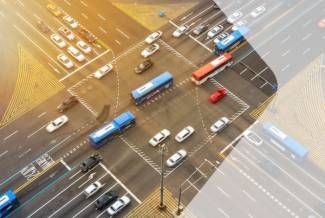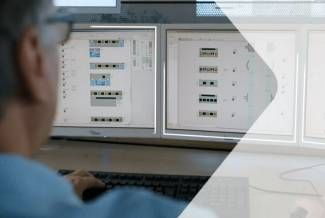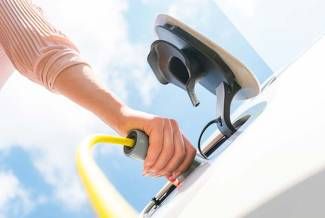Alternative drives: Climate-neutral mobility & alternatives to the combustion engine
A switch to alternative drive systems is an important cornerstone for the energy transition in transport to take place. If the provisions of the Paris Climate Agreement are followed, the classic combustion engine could soon be obsolete: From 2050 at the latest, ships should no longer be powered by heavy fuel oil, aircraft by paraffin and motor vehicles by petrol and diesel. Currently, hydrogen, electric and hybrid drives - as well as synthetic e-fuels - are considered possible CO₂-neutral fuels.
Definition: Alternative drive systems
All alternative drives have one thing in common: they must - in direct comparison to combustion engines - achieve environmental and sustainability effects, e.g. a positive CO₂ balance, but they must also be economical and efficient so that their use can be worthwhile.
Alternative drives that have no economic relevance in the automotive sector, whether for technical or economic reasons, will not become established. Of particular (ecological) interest are "zero-emission vehicles".
Good to know: The term alternative drive systems covers concepts for powering vehicles that differ in terms of their energy type and energy efficiency from the drive technologies commonly used on the market and have a positive effect on the environment.
Alternatives to the combustion engine
What sensible alternatives are there to the internal combustion engine? In addition to the electric drive, there are alternative drives with hydrogen and as hybrids.
Electric drive
Electrically powered vehicles are the prime example when it comes to alternative drives: after all, the electric motor is older than the internal combustion engine and was much more widespread around 1900 than it is today. In general, electric vehicles draw their energy from energy storage units, usually batteries, which are charged beforehand - ideally with green electricity.
Special feature of fuel cell vehicles: Fuel cell vehicles also belong to the category of electric drives. Here, the energy is not stored (e.g. in a lithium-ion battery), but the electricity is generated by converting a fuel (e.g. hydrogen). The electrical energy generated in this way then cranks up the vehicle's drive.
Good to know: Solar vehicles carry small energy storage units and also count as electric vehicles. However, only a few vehicles can run on direct sunlight, as for most cars and boats the energy required is much higher than the solar cells they carry could provide.
Hydrogen drive
A hydrogen drive – whether as a gas or in liquid form – releases only water and heat, but no pollutants. Hydrogen is used as fuel, and its eco-balance is particularly good when it is produced from green electricity (e.g. wind or solar).
The propulsion system, by the way, is a fuel cell. A strong chemical reaction takes place in it: Hydrogen and oxygen react to form water, which releases a lot of energy. This drives the electric motor as well as the entire on-board electronics - and the vehicle drives.
Good to know: In order for hydrogen to be transported in liquid form, it must be stored in an appropriate tank – at around 700 to 800 bar pressure. This is still considered a non-trivial technical challenge. But as a "zero-emission drive", hydrogen is also considered particularly promising for the future.
Hybrid drive
Hybrid vehicles have two drives – usually an electric motor and a combustion engine. Therefore, hybrid drives are not emission-free, but they also have advantages:
On short distances (in the city), the electric motor ensures a quiet & CO2-free ride.
On long distances, the combustion engine can be switched on.
Whenever the combustion engine is running, the battery is charged, e.g. according to the dynamo principle.
The aim of all hybrid drives is to combine the respective strengths and weaknesses of the different engines. Throughout Germany, more and more cars with hybrid drives are also being reported, which is probably also due to government subsidies
Good to know: The success story of the hybrid drive began with the Toyota Prius, which was even honoured in a Hollywood blockbuster in 2016 (film title: La La Land). In it, the "rich and beautiful of Hollywood" all drive a Prius - a clear statement for alternative, hybrid drives.
Alternative fuels
What if there was no need for alternative propulsion at all because the fuel I put in my vehicle is already sustainable or even CO₂-free? In fact, there are a number of alternative fuels that can help solve the problem (fewer emissions).
E-Fuels
In principle, e-fuels are synthetic fuels produced from renewable raw materials such as maize, rapeseed, wheat and palm oil (e.g. bioethanol). The competition with food cultivation is obvious and is rightly viewed critically.
But there is new research: Some experts are now focusing on hydrogen as the basic product for e-fuels. First, water is split into oxygen and hydrogen by electrolysis. This hydrogen is then combined with carbon dioxide - e.g. CO₂ from industrial waste or ambient air. The result: synthetic petrol and paraffin!
Good to know: Due to poor efficiency, e-fuels are less in discussion for cars than for aircraft and ships. And regardless of whether they are based on sugar beet or hydrogen, e-fuels have the potential to achieve CO₂ neutrality. Namely, if it contains just as much CO₂ - extracted from the atmosphere - as the vehicle consumes. Porsche has recently shown that this idea already works to 85 %.
Organic ethanol
Everyone knows the designation E10 from the petrol station. This stands for 10 % ethanol content in petrol. With bioethanol, the fuel is produced exclusively from biomass - e.g. from straw, wood or other plant waste. This ensures a solid CO₂ balance, as the CO₂ burnt in the engine was originally removed from the atmosphere (for plant growth).
Good to know: Theoretically, combustion engines can also run on 100 % bioethanol (E100), but an 85 % mixture, i.e. E85, is more common.
Biodiesel
Biodiesel is more or less the equivalent of organic ethanol, but animal or vegetable fats (e.g. rapeseed oil) are used for its production and not plant waste. Here, too, the argument must be heard that agricultural land is occupied for the production of fuel – instead of food.
Good to know: Whether biodiesel is really climate-friendly ultimately depends on how much CO₂ is produced during the cultivation and harvesting (or rearing of animals) of the raw materials used.
Vegetable oil
Various vegetable oils can also be poured into a diesel tank unrefined. In this case, however, the engine would have to be converted, as vegetable oils ignite less easily than classic diesel.
Good to know: Due to the higher viscosity and high ignition temperature of vegetable oil, you would have to fill up with real diesel, especially in winter, as otherwise you run the risk of the vehicle not starting.
LPG (Autogas)
LPG (Liquefied Petroleum Gas) is often considered a cheap alternative to diesel and petrol. LPG is a by-product of oil and natural gas refining.
Although it releases up to 80 % less nitrogen oxides and emits fewer pollutants overall, it is not 100 % sustainable.
Good to know: As a by-product of crude oil and natural gas, LPG is based on finite energy sources. After all, no additional crude oil has to be extracted during the production process. If you like, you can speak of a waste product of diesel and petrol extraction.
Natural gas
Natural gas consists largely of methane. Its energy density is low. To power a vehicle, natural gas must therefore be compressed enormously, which costs a lot of energy. This is why you also find the designation CNG (Compressed Natural Gas) at petrol stations.
Good to know: Natural gas should not be confused with LPG, even though both gases power internal combustion engines. Since natural gas emits up to 25 % less CO₂ and fewer pollutants, it is currently considered a transitional solution until real sustainable alternatives are ready for the market.
Electric Drive
No direct emissions
+ Zero CO₂ while driving
+ Financial support from the government
- Good eco-balance only with "green" power source.
- Problematic sources of raw materials for the production of the batteries
- Comparatively heavy vehicles (weight) with limited range
Hydrogen Drive
+ Zero emissions (no CO₂ is produced)
+ Unlimited range (depending on tank filling).
+ Optimal with green electricity for production
+ Financially supported
- Energy-intensive production
- Few suitable infrastructure (e.g. filling stations) available
- Few models commercially available
Hybrid Drive
+ More range than electric cars
+ No direct emissions for short journeys
+ Positive eco-balance especially in cities
+ Financially supported
- Vehicles are heavier
- Less space in the boot
- Disposal problems of the lithium-ion battery
Natural Gas (CNG)
+ Less emissions
+ Favourable alternative
+ Favourable tax treatment
- From 2027, the tax reduction will be abolished
- Few filling stations
- High conversion costs
- Transitional solution
LPG
+ Low-emission drive
+ Cost point
+ Reduced tax until 2022
- Higher consumption compared to petrol
- By-product of crude oil & natural gas (= finite energy source)
Organic Ethanol
+ Low-emission combustion
+ High engine power
- Competition with food cultivation
- Much energy needed for production
Biodiesel
+ Better eco-balance than normal diesel
- High nitrogen emissions
- Energy intensive production
- Competition with food cultivation
Vegetable Oil
+ Low emission of fine dust
- Modifications necessary
- Often only suitable for old diesel
- Competition with food cultivation
E-Fuels
+ Synthetic fuels, from renewable raw materials
+ Can also be produced from hydrogen
+ Potential for CO₂ neutrality.
- Competition with food cultivation - if obtained from natural raw materials.
- CO₂-neutral only if exactly as much CO₂ is bound in the fuel as is consumed.
Alternative Drive Systems: Solutions
Concrete solutions by SWARCO
SWARCO has many years of experience with mobility solutions that support the expansion of alternative drives.
Here is a selection:
Good to know: We at SWARCO believe that the widespread introduction of alternative drive systems is necessary in order to achieve agreed climate targets.
Conclusion: Alternative Drive Systems
The revolution of alternative drive systems consists in the drastic reduction of CO₂ emissions up to zero emissions. Strictly speaking, however, this includes all emissions, i.e. particulate matter, nitrogen oxides etc.
Compared to the internal combustion engine, many alternatives are still quite expensive. But a great deal of research is underway to eliminate crucial "birth pains" - e.g. stable tanks, better efficiency, green electricity, infrastructure and much more. - and many more.
Hardly any expert doubts that the future belongs to alternative drives such as hydrogen or electromobility.
Last but not least: alternative drives and fuels will sooner or later free us from our dependence on oil. This has not only enormous ecological and economic advantages, but also - with a view to many producing countries - political ones. More and more passenger cars with fuel cell, hybrid or electric engines are currently being registered in Germany: So the ball is rolling.
FAQs – Frequently Asked Questions
The most well-known alternative drives and fuels include the following:
Electric drive
Hydrogen drive
Hybrid drive
LPG (liquefied petroleum gas)
Natural gas (CNG)
Bioethanol
Biodiesel
Vegetable oil
On this question, there are arguments in favour of both electric drive and hydrogen. The ecological concerns about the batteries and the low energy efficiency nag at electric cars. Fuel cells and hydrogen tanks win the race, especially if the hydrogen is produced purely from green electricity (solar or wind power).
Surprisingly, cars powered by natural gas (CNG) currently have the best climate footprint and even rank ahead of e-cars. The reason for this is the raw material- and energy-intensive production of the batteries and the electricity mix at German filling stations.
All alternative propulsion systems must achieve positive environmental effects, but at the same time be economical and efficient so that their use is worthwhile. Then they have the potential to make an important contribution to sustainable mobility.
Learn more about >>> Sustainable mobility
The mobility of the future lies in digitalisation: Big Data, 5G, artificial intelligence and more connectivity increase safety, improve efficiency and reduce environmental pollution. The resulting mobility concepts are setting profound changes in motion.

STAY INFORMED
GET OUR NEWSLETTER!
Subscribe to our ITS / Smart Mobility Newsletter and receive regular updates on trends, developments, solutions and events.




